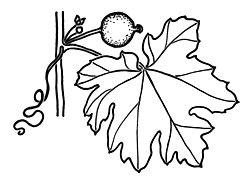Common name: Desert Cucumber
Austrobryonia micrantha (F.Muell.) I.Telford APNI* Synonyms: Zehneria micrantha (F.Muell.) F.Muell. APNI*
Melothria micrantha APNI*
Mukia micrantha (F.Muell.) F.Muell. APNI*

Description: Perennial herb with thickened rootstock. Stems annual, prostrate, to several metres long, 0.4–2 mm diameter, ribbed, sparsely scabrid to glabrescent. Tendrils simple, to 40 mm long.
Leaves scabrid, broad-ovate, cordate, 15–60 mm long, 12–45 mm wide, dentate or shallowly 3–7-lobed, the lobes dentate, scabrid with tubercle based hairs on both surfaces, more densely abaxially.
Male flowers: 1–3 per fascicle; pedicels 3–5 mm long; hypanthium broad-campanulate, 1–1.5 mm long, puberulous externally; calyx lobes narrow-triangular, 1–1.2 mm long, puberulous abaxially; corolla lobes obtuse, glabrous adaxially, puberulous and glandular abaxially, yellow-green. Female flowers: 2–5 per fascicle; pedicels 3–8 mm long; perianth similar to males.
Fruit subglobose to ellipsoidal, 10–14 mm long, 7–13 mm diam.; fruiting pedicel to 18 mm long. Seeds 5–20, ovate, 4–6.5 mm long, 2.5–3.5 mm wide, compressed, smooth, pale buff.
Flowering: Flowering and fruiting from January to May.
Distribution and occurrence: Widespread through inland Australia in the Lake Eyre and Murray-Darling Basins from the Finke River, Northern Territory, eastwards to near Boulia in Queensland and Louth in New South Wales, southwards to the Wimmera in Victoria . Typically found on clay soils of river flood plains, waterhole and dam margins and swales in dunefields, often forming dense mats. The thickened rootstock drying out and then regrowing when water becomes plentiful.
NSW subdivisions: SWP, NFWP, SFWP
Other Australian states: Vic. N.T.
Text by Louisa Murray
Taxon concept: Schaefer, H.,Telford, R.H and Renner, S.S. (2008) Systematic Botany, 33(1): pp. 125-132
APNI* Provides a link to the Australian Plant Name Index (hosted by the Australian National Botanic Gardens) for comprehensive bibliographic data
***The AVH map option provides a detailed interactive Australia wide distribution map drawn from collections held by all major Australian herbaria participating in the Australian Virtual Herbarium project.
|


